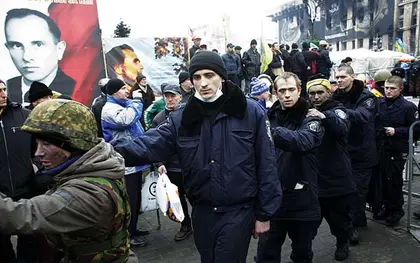As journalists on the morning of Feb. 20 were escorted into the state-owned Energy Company of Ukraine building near Kyiv City Hall, where the newly captured police officers are being held, the prisoners stood up as if they were getting ready for an inspection.
Some 60 police officers were captured by protesters on Feb. 20 during violent clashes that killed at least 49 people. Most of the fatalities were protesters shot to death by police, but at least three were police officers killed in the clashes.
JOIN US ON TELEGRAM
Follow our coverage of the war on the @Kyivpost_official.
Both sides blamed each other for igniting the deadly conflict on Feb. 20.
President Viktor Yanukovych accused the protesters of attacking police positions on Kyiv’s Independence Square. Protesters accuse police of starting the conflict by throwing Molotov cocktails and improvised explosive devices at them.
Whatever happened on the ground, the truth is that both sides were too close to each other and were spoiling for a fight.
The captured police officers came from other parts of Ukraine — Dnipropetrovsk, Kryvyi Rih, Crimea and Luhansk. Some were seasoned veterans, others looked like inexperienced teenagers. None were given weapons except rubber truncheons.
The commander of a Crimean unit Tymur Tsoi said the officers that he brought were staying in October Palace when the protesters came. “They asked us to leave the building and so we did,” he confirmed. Others soon followed.
The police from Dnipropetrovsk arrived at 4 a.m. on Feb. 20 and were awakened with an order by a commander to leave the building and to prepare to enforce police lines. That is when protesters attacked and captured them.
“I am not sure what was going on, I was sleeping,” said unit commander Vasyl Tur. “We got surrounded right away, the others were running and me and my greenhorns were left out.”
They were escorted to the EuroMaidan stage, where some of them received medical care after being struck by protesters.
Then they were marched to the Energy Company building on Khreshchatyk Street.
The police captured by protesters were not armed.
“Police have only a standard set of protection – bulletproof vests, protective gear for legs and arms, helmets, rubber truncheons and handcuffs,” Tsoi said. “We have firearms, but didn’t take them with us.”
Tsoi said the use of firearms requires separate written permission which was not forthcoming. He said their only orders were to protect buildings where high-ranking officials are located.
“Police were just holding up the cordons,” Tsoi said. “And yes, if you want to call it that, we were used as a live shield.”
Mykhailo Dashko, 21, stood closer to the wall, his uniform burned.
“A Molotov cocktail hit me a couple of days ago, I wasn’t hurt, it’s just the clothing,” he said.
Dashko is from a Crimean unit that arrived a month ago. Earlier the unit was located on Hrushevskoho Street, where four protesters died in January.
“It was fine there, food was always delivered on time,” the police officer said. But they were hungry on Feb. 20, with no food for 24 hours. So captivity came with some benefits. “We only received food here, some apples and water and they said they are bringing cheese and milk,” he said.
Dashko’s tour of duty was supposed to end on Feb. 23. “It is soon, but I don’t even know what day is it now, what do you think, will they let me go home?” he asked.
Police officer Maksym Prytys, 19, had a face covered with bruises and small cuts, one of the few injured during the Ukrainian House takeover. “We went out and were attacked just within two to three minutes, some started kicking me. I didn’t see who or how. I was covering my head with the shield,” he said.
Tur, the commander of the Dnipropetrovsk unit, encouraged officers to talk to journalists. “Hey! Why are you scared! Tell them everything.What do we have to lose?” he asked.
The fate of the police-turned-prisoners is unclear. The Interior Ministry reserved the right to use force to free them.
Tsoi said that the prisoners’ fate will likely rest on negotiations between politicians and protesters.
Oleksiy Kabatskyi, 21, a captured police officer from Luhansk was taken with six officers from his unit. He wants to quit. “Now I just want to go home and work a normal job. I don’t want to pick any sides,” he said.
Kyiv Post staff writer Daryna Shevchenko can be reached at [email protected].
You can also highlight the text and press Ctrl + Enter




